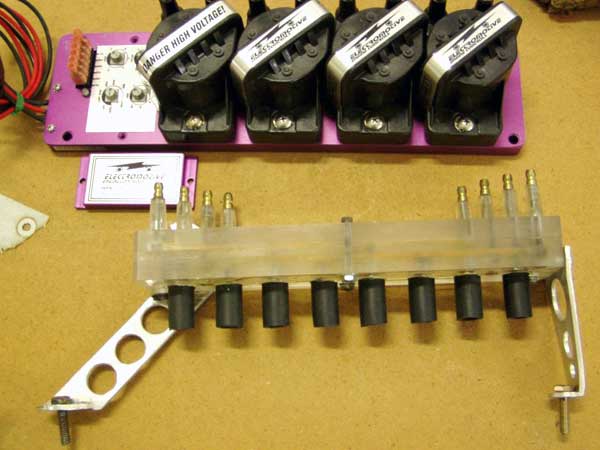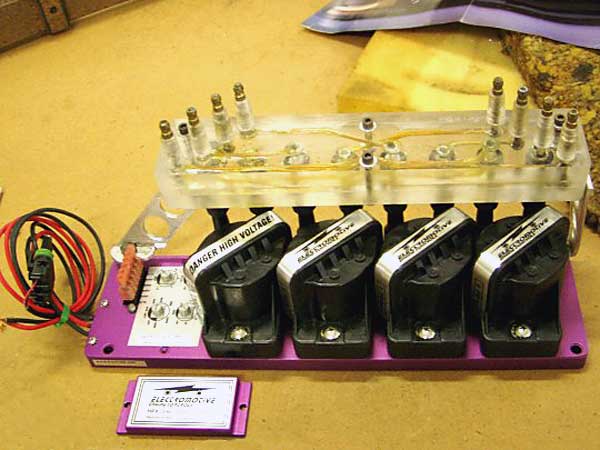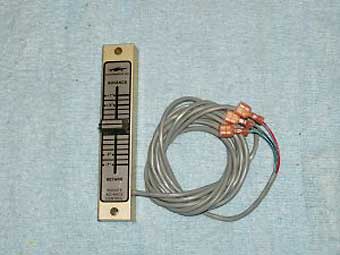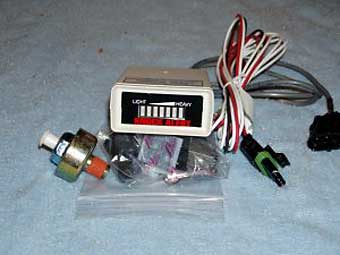�
�
�
�
�
�
�

� Electromotive Direct Ignition Controller & Coil Assembly (top), & Custom Distribution Manifold (bottom)� �
� by: Howard Fitzcharles�
� Distributor ignition is OK up to a point, but when you look at the drive of most distributors � you will see a lot of free play between the piston position and whatever is in the distributor � that actually triggers the coil. Whether it's a set of points, a light emitting diode, an � electromagnet or whatever. Then you have to fire a coil, sending current to the distibutor cap,� along to a carbon brush, then to a rotor, jumping a gap to a peg, and back out of the cap to a � wire before it gets to the spark plug where it is trying to jump another gap to light a fire � in the combustion chamber. Whew - what a trip!�
� Maximum horsepower, as far as ignition timing is concerned, occurs when ignition timing is � advanced right up to almost the point of detonation. In other words, if you were to advance your � timing slowly until you got detonation you would see horsepower increase until you reached an � abnormal combustion (which is commonly misnamed valve ping or valve rattle). The trouble with � detonation is that high RPM detonation is not easily heard, unlike the low-RPM-under-load � detonation "rattle". With gear lash and timing-chain stretch causing loose play in the drive � of a distributor, at speed the drive is bouncing back and forth so you must keep the timing � slightly retarded to account for the variation in the actual timing. You have shorted yourself � on power because you are forced to run a slightly retarded timing because of this "spark scatter" � variation. An ignition that is triggered directly off the crankshaft is much more accurate and � consistent. �
�
�
�

� Electromotive Direct Ignition Controller & Coil Assembly (top), & Custom Distribution Manifold (bottom)�
Direct Ignition and Tuning Equipment
� as published in British V8 Newsletter, Volume XIV Issue 3, December 2006�� by: Howard Fitzcharles�
� Distributor ignition is OK up to a point, but when you look at the drive of most distributors � you will see a lot of free play between the piston position and whatever is in the distributor � that actually triggers the coil. Whether it's a set of points, a light emitting diode, an � electromagnet or whatever. Then you have to fire a coil, sending current to the distibutor cap,� along to a carbon brush, then to a rotor, jumping a gap to a peg, and back out of the cap to a � wire before it gets to the spark plug where it is trying to jump another gap to light a fire � in the combustion chamber. Whew - what a trip!�
� Maximum horsepower, as far as ignition timing is concerned, occurs when ignition timing is � advanced right up to almost the point of detonation. In other words, if you were to advance your � timing slowly until you got detonation you would see horsepower increase until you reached an � abnormal combustion (which is commonly misnamed valve ping or valve rattle). The trouble with � detonation is that high RPM detonation is not easily heard, unlike the low-RPM-under-load � detonation "rattle". With gear lash and timing-chain stretch causing loose play in the drive � of a distributor, at speed the drive is bouncing back and forth so you must keep the timing � slightly retarded to account for the variation in the actual timing. You have shorted yourself � on power because you are forced to run a slightly retarded timing because of this "spark scatter" � variation. An ignition that is triggered directly off the crankshaft is much more accurate and � consistent. �
�
�
Because a more consistent initial signal allows more timing advance, higher combustion chamber �
pressures are achieved. The final result is that the engine produces more power!�
� What about ignition timing through the RPM range? Most Kettering ignition (standard "points � type") systems use a combination of vacuum control and centrifugal controls to get the timing � close to what is needed through the RPM and load range. Here, they really get sloppy and - � guess what! - as soon as you make any significant modifications to your engine you completely � change the needed advance curve of the distributor. You can NOT guess what this new curve is. � You will need a "distributor machine" to even change the curve. And guess what again! You may � find it hard to even find one in your town. Call some repair shops and see. A race car shop � will be your best bet. What curve is best for your particular engine can be different than � another identical engine. �
��
�
� What to do? It's simple: Direct Ignition! In a typical direct ignition system, a trigger-wheel � is mounted on the crank pulley and a sensor (called a "pick-up") is mounted close to that wheel. � Crank position, as sensed by the pick-up, is the basis for ignition timing. Direct ignition also � uses a different coil strategy, wherein the ignition fires spark plugs directly from multiple� coils and not through a distributor cap and rotor. Each coil has two spark plug wire terminals� that are in turn wired to two conventional spark plugs. (One spark plug fires on compression � while simultaneously the companion spark plug fires simultaneously on exhaust.) The advance � curve is handled electrically; knobs on a control panel allow a user to dial in the advance � through several RPM ranges. Using these controls, one can optimize the advance curve to match � your particular engine. One of the dials is a rev-limiter adjustment. A MAP sensor senses � manifold pressure changes, as another input to the electronic controller.�
��
 �
�
�
�
�
�
� What about ignition timing through the RPM range? Most Kettering ignition (standard "points � type") systems use a combination of vacuum control and centrifugal controls to get the timing � close to what is needed through the RPM and load range. Here, they really get sloppy and - � guess what! - as soon as you make any significant modifications to your engine you completely � change the needed advance curve of the distributor. You can NOT guess what this new curve is. � You will need a "distributor machine" to even change the curve. And guess what again! You may � find it hard to even find one in your town. Call some repair shops and see. A race car shop � will be your best bet. What curve is best for your particular engine can be different than � another identical engine. �
�
| �
Enjoying this article? Our magazine is funded through the generous support of readers like you! � To contribute to our operating budget, please click here and follow the instructions. � (Suggested contribution is twenty bucks per year. Feel free to give more!)� |
� What to do? It's simple: Direct Ignition! In a typical direct ignition system, a trigger-wheel � is mounted on the crank pulley and a sensor (called a "pick-up") is mounted close to that wheel. � Crank position, as sensed by the pick-up, is the basis for ignition timing. Direct ignition also � uses a different coil strategy, wherein the ignition fires spark plugs directly from multiple� coils and not through a distributor cap and rotor. Each coil has two spark plug wire terminals� that are in turn wired to two conventional spark plugs. (One spark plug fires on compression � while simultaneously the companion spark plug fires simultaneously on exhaust.) The advance � curve is handled electrically; knobs on a control panel allow a user to dial in the advance � through several RPM ranges. Using these controls, one can optimize the advance curve to match � your particular engine. One of the dials is a rev-limiter adjustment. A MAP sensor senses � manifold pressure changes, as another input to the electronic controller.�
�
 �
�
�
�
I have selected an Electromotive brand direct ignition system for my Buick 215cid V8 engine. �
�
One thing that sets the Electromotive "XDI" system apart is the ability to charge multiple �
ignition coils at the same time. The resulting benefit is increased dwell time (up to �
at least sixty degrees and about 1000 microseconds). Unlike capacitive discharge systems �
that only put out one very short spark, the XDI puts out a fuller, longer-burning spark at �
high engine speed. The longer burn time assures effective burning of even lean or poorly �
balanced fuel mixtures. Full spark energy is available over the entire RPM range. �
� �
�
�
�
 �
�
� An optional timing control can be mounted inside the cockpit for fine adjustment of timing as � conditions (such as temperature, fuel quality, etc.) change. �
� How do I know what to set the adjustable timing to? I use an LED display from a knock sensor � system made by MSD. The knock sensor sends a signal to the display of LEDs. This way, no matter � what the present conditions are, I can keep the ignition timing to an optimum by reading the � LED display and setting the timing to it's optimum. The MSD knock sensor can read detonation � and give me a display when I can not hear any detonation. This is especially true at high RPM. � Detonation (abnormal combustion) can destroy an engine in just a few minutes of high RPM � running.
� If you are into fuel injection you will find that Electromotive has a cool system that handles � fuel control also. �
�
�
�
�
 �
�
�
�
 �
�
� An optional timing control can be mounted inside the cockpit for fine adjustment of timing as � conditions (such as temperature, fuel quality, etc.) change. �
� How do I know what to set the adjustable timing to? I use an LED display from a knock sensor � system made by MSD. The knock sensor sends a signal to the display of LEDs. This way, no matter � what the present conditions are, I can keep the ignition timing to an optimum by reading the � LED display and setting the timing to it's optimum. The MSD knock sensor can read detonation � and give me a display when I can not hear any detonation. This is especially true at high RPM. � Detonation (abnormal combustion) can destroy an engine in just a few minutes of high RPM � running.
� If you are into fuel injection you will find that Electromotive has a cool system that handles � fuel control also. �
�
�
Another very practical tuning aid is called "G-Tech Pro", which is a computer that stores, �
analyzes, and reports the output of integral accelerometers over time. One use of the G-Tech �
analyzer is engine tuning: if you know the weight of your car and enter it into the computer, �
the device can calculate (wheel) horsepower based on the car's actual forward acceleration. �
I first saw one of these units in a friend's car a few years ago. (The "car" was a turbo-charged �
aluminum-block 350 Chevy powered Datsun PU.) My friend Oz had the engine on a dyno and �
knew what it should show as horsepower. We were impressed that the G-Tech numbers matched �
the actual dynomometer consistently. �
� G-Tech Pro has three accelerometers. One accelerometer measures lateral acceleration, which is � very useful for tire and suspension tuning and driver training. G-Tech tools are a great tool � for autocrossers! �
� A "z-axis" accelerometer measures up-and-down acceleration. This extra sensor provides a big � technical advantage: G-Tech Pro can automatically detect and compensate for suspension � lift or dive which would otherwise compromise accuracy. �
� The basic model, called "G-Tech Pro SS", currently costs about $199. The "G-Tech Pro RR" (which � replaces the now-obsolete "G-Tech Pro Competition" model) can interface with a laptop computer. � At about $299, this unit costs less than a few dyno pulls on an engine dyno! I used to race � motorcycles professionally and didn't have such tools so I had to make estimates by timing high � speed test runs on straight highway. (Much more dangerous than racing on a race track!) With a � G-Tech Pro you can make all of your tests and not spin a wheel or go over the highway speed � limit. Cool! �
� Check out Howard's website! MG's, Triumphs & Jaguars: www.mg-tri-jag.net�
� Disclaimer: This page was researched and written by Howard Fitzcharles. Views expressed � are those of the author, and are provided without warrantee or guarantee. Apply at your � own risk.�
� Photos by Howard Fitzcharles. All rights reserved. �
�
�
� G-Tech Pro has three accelerometers. One accelerometer measures lateral acceleration, which is � very useful for tire and suspension tuning and driver training. G-Tech tools are a great tool � for autocrossers! �
� A "z-axis" accelerometer measures up-and-down acceleration. This extra sensor provides a big � technical advantage: G-Tech Pro can automatically detect and compensate for suspension � lift or dive which would otherwise compromise accuracy. �
� The basic model, called "G-Tech Pro SS", currently costs about $199. The "G-Tech Pro RR" (which � replaces the now-obsolete "G-Tech Pro Competition" model) can interface with a laptop computer. � At about $299, this unit costs less than a few dyno pulls on an engine dyno! I used to race � motorcycles professionally and didn't have such tools so I had to make estimates by timing high � speed test runs on straight highway. (Much more dangerous than racing on a race track!) With a � G-Tech Pro you can make all of your tests and not spin a wheel or go over the highway speed � limit. Cool! �
� Check out Howard's website! MG's, Triumphs & Jaguars: www.mg-tri-jag.net�
� Disclaimer: This page was researched and written by Howard Fitzcharles. Views expressed � are those of the author, and are provided without warrantee or guarantee. Apply at your � own risk.�
� Photos by Howard Fitzcharles. All rights reserved. �

